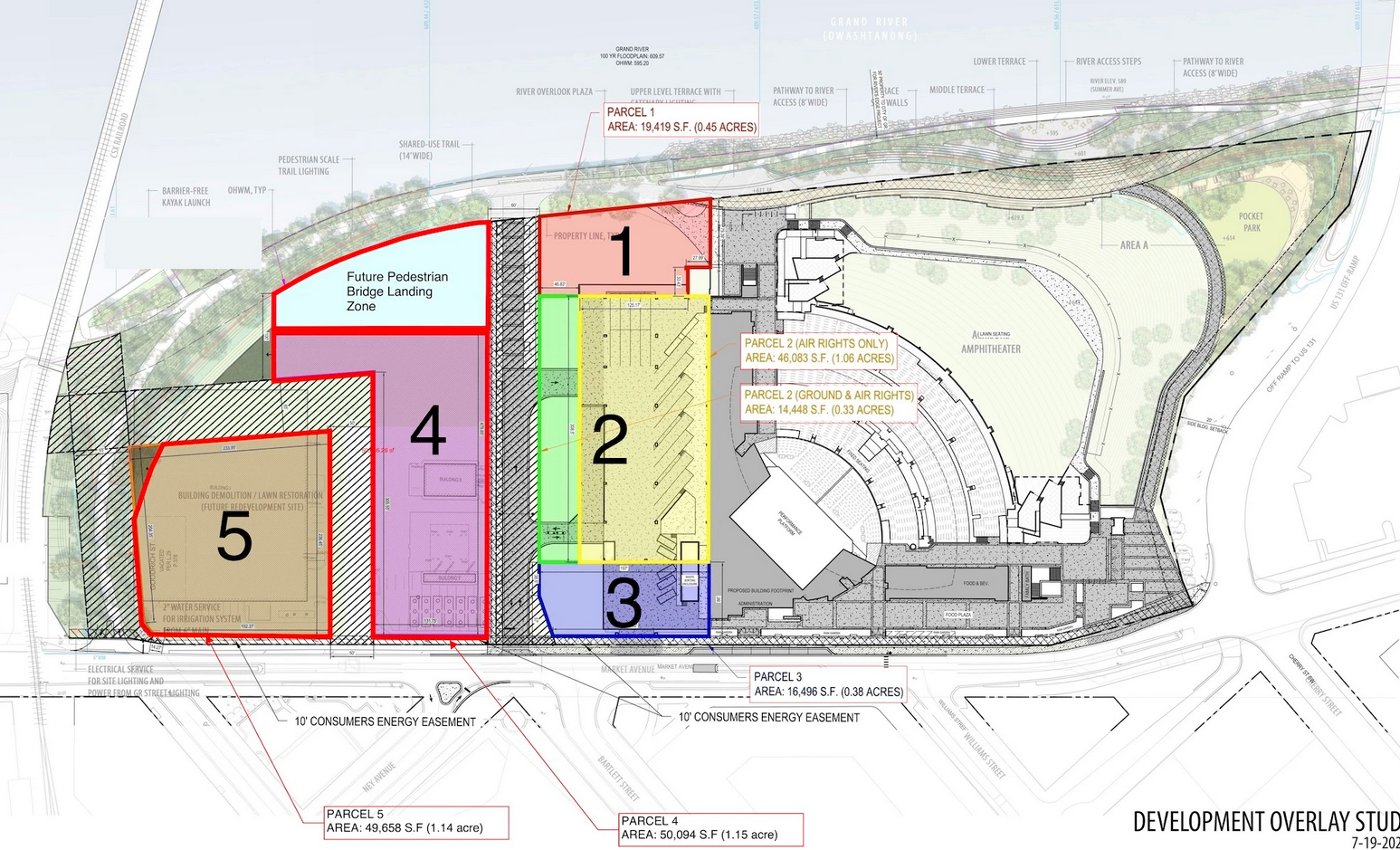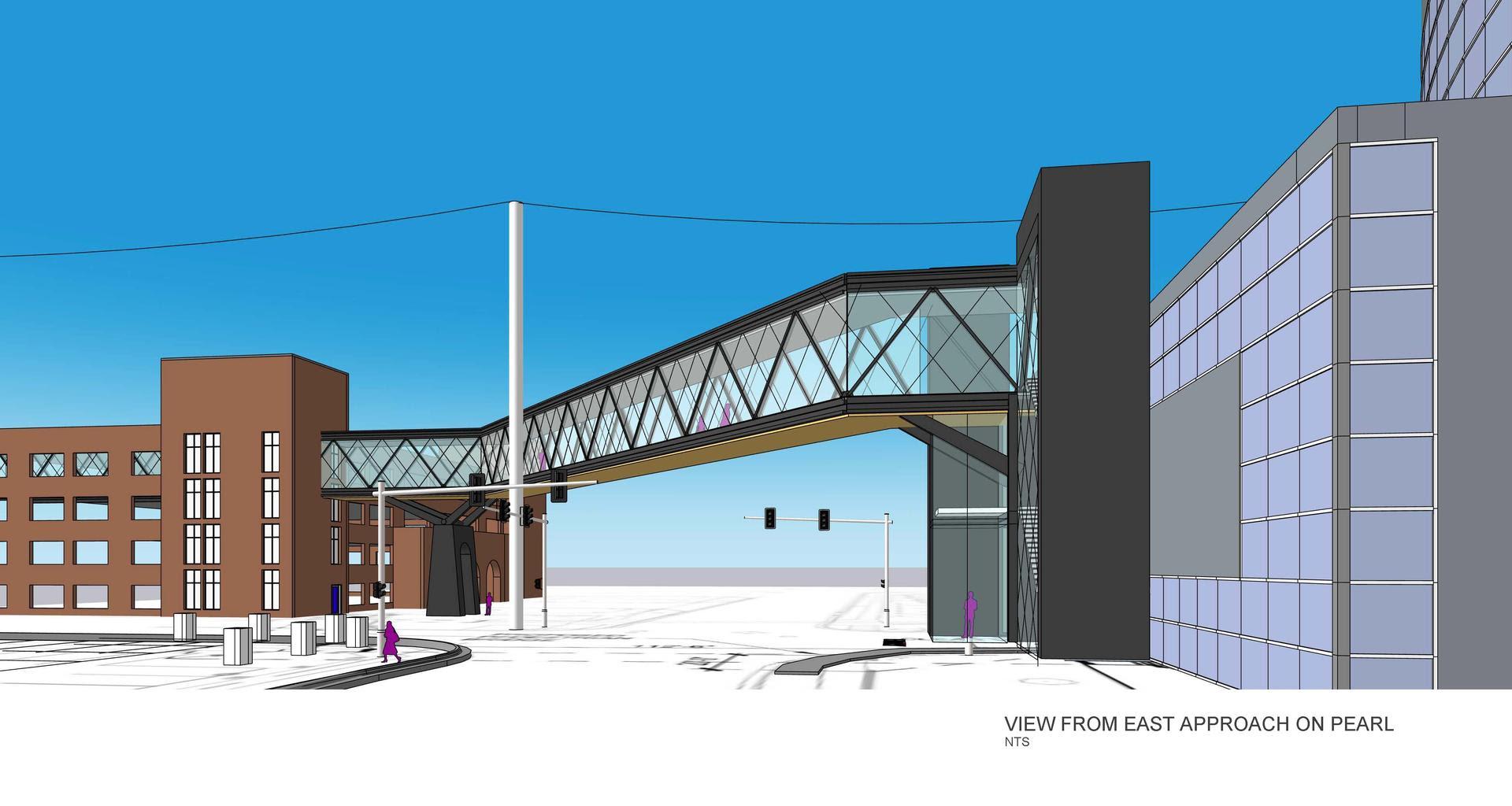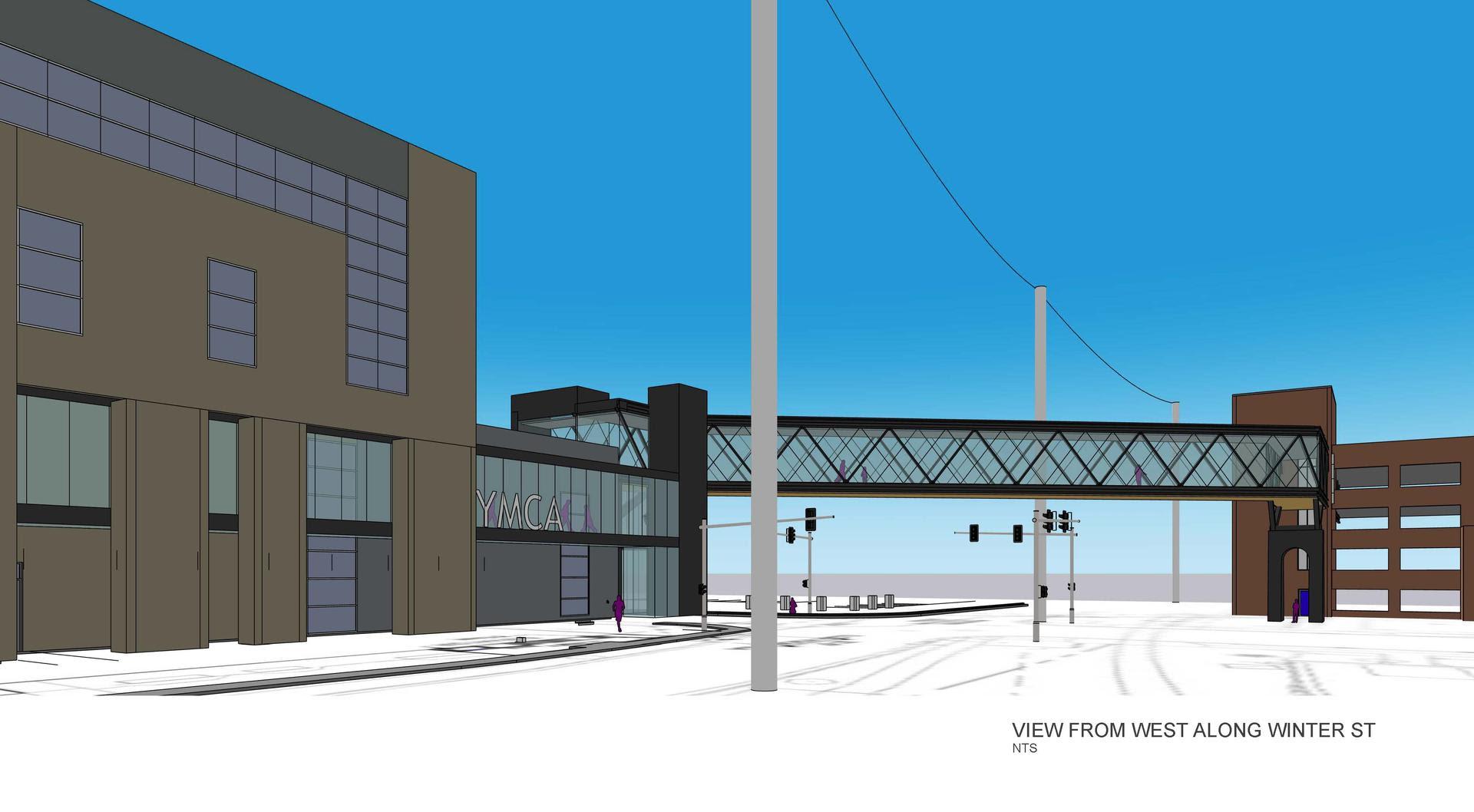The Stadium & The Amphitheater, Some Basics
UPDATE 2025-08-26: Added map of amphitheater development sites.
The amphitheater and the soccer stadium have flooded the news. However, there is a lot of news, as well as a lot of misinformation. For convenience and simplicity . . .
The Basics
The basics of the currently four (4) proposed projects are as follows:
| Development | Cost | Start | Completion | Description |
|---|---|---|---|---|
| Stadium | $172,000,000 | April/May 2025 | Spring 2026 | 8,500 seat stadium with retail and restaurant facilities |
| Stadium Tower | $114,400,000 | ? | Fall 2027? | 18 stories; 9 residential (260 units), 350 space parking deck, 20Ksq/ft office, 10Ksq/ft retail |
| Amphitheater | $186,000,000 | Spring 2024 | May 2026 | 12,160 seat capacity amphitheater |
| Amphitheater Tower | $219,000,000 | ? | Spring 2028? | 21 story; 15 residential (475 units), 815 space parking deck w/340 reserved for amphitheaters. |
The real transformative component of both of these venues for downtown, and the adjacent corridors and neighborhoods, would the residential towers.
No developers have signed on for the tower developments at either site; Grand Action, the Downtown Development Authority (DDA), and The City will need to shop around for takers. The recent history of tower development in the city has not been promising. The most recent project to get cancelled being the 10-story McConnell in 2022. Aside from Studio Park Tower, on an existing podium, there has been no new residential development over six stories in the last decade. Even development in the now amenity rich Bridge St corridor has been mid-rise [Barley Flats, Bridge St Lofts, Bridge St Market - all four floors of residential].
The parking scenario proposed by the residential towers is disappointing [assuming they happen!]. While pitching both of these projects to citizens The City and Grand Action proclaimed there was ample existing parking to support both venues. Yet the auxiliary development for both sites includes a substantial amount of traffic congestion and air pollution inducing deck parking. The amphitheater tower parking deck provides a 1:1 parking allocation for each residential unit, demonstrating that neither The City or Grand Action have yet to learn how to even spell TOD (Transit Oriented Development). 😞
Grand Action has previously projected that the venue developments will ultimately result in 1,500 - 1,700 housing units; those projections are 2.0x to 2.3x that included in the currently theoretical residential towers. We'll have to wait and see.
Economics
There's a lot of misinformation about the economics of these projects.
Simple: no checks are being written. Or, almost no checks, or not by us. Some components of the projects will be paid for by the city, most notably the movement of the public services from the amphitheater site to the Scribner site. The DDA will also be constructing the riverside trail on the amphitheater site . . . but, really, that's infrastructure which should be built anyway. The majority of the funds are either private or coming from state of Michigan. As the state of Michigan loots its cities, redistributing our tax revenues out to the economically unproductive regions of the state, its about time Grand Rapids gets some of its cheddar back. The various tax incentives are going-forward incentives over the next ~20 years and will benefit nobody other than those who incur the cost of building.
The sites in question, today, generate negligible property tax revenue. The former Big Boy restaurant (407 Pearl St) paid $42,581 in property tax in 2023 and will convert to publicly owned [and thus not taxable] property. Otherwise all ~20 acres of the proposed sites is currently publicly owned and generating no revenue. Both venues will be owned by the Convention Authority, which is a public entity.
The sites, in question, also generate negligible income tax revenue. The net loss is the income tax paid by the waiters and cooks at the Big Boy. The tax capture incentives include state income tax [which again, is largely poached for the rest of the state], while the city itself will continue to collect its state-capped maximum income tax of 1.5%. IF those residential developments come to fruition they will provide ~882 new citizens paying municipal income tax, in addition to those employed at the venues themselves. That could easily total to nearly $1,000,000/yr in general fund revenue. Aside from the 32% dedicated to the police department by the city's charter general fund revenue is the revenue our elected commissions get to use most freely; general fund revenue is good.
IF the venue developments result in the 1,500 - 1,700 housing units posited by Grand Action that would result in ~$1,770,000/yr - $~2,007,000/yr in municipal income tax; in total.
Details: The city is selling the amphitheater site (201, 225, 233 and 301 Market Ave. SW) to the Convention Authority for $24,300,000, and has purchased the site at 1500 Scribner Ave. NW from Kent county for $7,450,000; the county facilities previously at 1500 Scribner are relocating to WalkerView Industrial Park. Both of these transactions are the sale of property from one public entity to another. The city has invested ~$62,000,000 in the relocation of the facilities for a net cost of ~$37,700,000 relative to the sale of the Market Ave property. In the end the city will have a new, modern, maintenance facility . . . how much is that worth? I don't know how to quantify that, other than that it is certainly worth much more than nothing.
The direct contribution of the city to the construction of the amphitheater is $20,500,000 through a bond sale - no private entity can match the terms and rates available to a municipality with a high-rating.
Connectivity
The amphitheater includes the construction of a publicly owned 12ft wide path along the Grand River from US-131 south to where the railroad tracks cross the river. The construction and funding of the path will be managed by the Downtown Development Authority (DDA). This path is intended to be the spine connecting a the variety of other trails which converge south of downtown, and then link those routes to downtown . . . although how that interfaces to downtown under US-131 remains unclear.
A bike lane [or possibly even just a bike gutter] is included in the plans on Mt. Vernon Ave along the backside of the stadium, sandwiched up against the US-131 expressway and intermixed with traffic exiting from and entering the expressway. It is difficult to imagine that as either a useful or pleasant connection. Maybe we'll get a covered bus stop? 🙄 Again, Grand Action don't do TOD.
The minutes from the Rapid's March Planning & Technology Committee meeting indicates that the Rapid is being included in conversations about the venue and hints at the possibility of a preferred entrance for transit users; which is something which could be a real amenity,

What does "an extension of our BRT service" mean? I don't know. Hopefully, that means later hour service, at least on event nights. 🤞 We certainly aren't going to get the funding for extended service from the state of Michigan under the Whitmer administration which proposes transit funding cuts in every budget. 😠
Affordable Housing
In order to maximum the tax incentives for both residential towers the developer would need to either commit to 20% of units being Affordable at 100% AMI for twenty (20) years or make equivalent payments into the city's affordable housing fund for a period of twenty (20) years. If the developer chooses to income restrict units this would create 146 income restricted units; 94 in the amphitheater tower, and 52 in the stadium town. Otherwise the Affordable Housing Fund contribution would be ~$2,500,000 for the stadium tower and ~$5,900,000 for the amphitheater tower [a potential total contribution of ~$8,400,000].
The current Area Median Income for Kent county is ~$75,000/yr. See "What is affordable" for an explanation on affordability calculations.
The Amphitheater
Future Development
The amphitheater has five designated future development sites; or four future development sites and one future future development site as area #5 has not yet been cleared. All of these,other than #5, are air-right development sites [over existing structures and infrastructure].
 |
As of August 2025 no development has been proposed on any of the sites.
The Stadium

The Skywalk
As the GVSU parking ramp is the primary proposed parking solution for users of the YMCA - as the Stadium displaces current parking capacity - a skywalk over the railroad, Lake Michigan Drive, and Winter Ave has been proposed (2025-02). This would connect the fourth floor of the GVSI parking ramp with a stair and elevator tower abutting the YMCA. An entrance from the tower to the YMCA would exist on the second floor of the tower; there would be street level access as well. The length of the skywalk would total 225 feet and have an elevation of thirty (30) feet over the grade of the railroad which is the highest point of the underlying right-of-way.
The Planning Department application for the skywalk was as follows (paragraph breaks introduced for readability, highlights are also added to the original text):
| On March 28, 2024, the City of Grand Rapids City Planning Commission granted special land use approval for a proposed soccer stadium at 230 Winter Avenue NW (PC-SLU-2024-0013). Now named Amway Stadium, this 8,500-seat arena features a pitch, team store, restaurant, private suites, and two entry and exit plazas. Frequency of events and hours of operation for the stadium, club/restaurant, and outdoor plaza remain unchanged and will comply with the conditions of approval for the initial Special Land Use request.
As the stadium is located in the City Center zone district, no off-street parking is required on-site. However, to accommodate patrons and members of the adjacent YMCA, an agreement has been made with Grand Valley State University (GVSU) for use of their surface parking lots and structured parking located along Lake Michigan Drive. The request before the Planning Commission today is special land use approval for an overhead walkway connecting the YMCA located at 475 Lake Michigan Drive NW and the GVSU Seward Parking Lot Ramp located at 500 Lake Michigan Drive NW. The proposed bridge will be an encroachment above the intersection of Lake Michigan Drive and Winter Avenue as indicated in the attached drawings. The bridge structure is intended to be 225’ long by 12’ wide by 16’ tall box truss (exterior dimensions) that spans the entire right of way of the intersection between the 4th floor of the GVSU parking garage at 500 Lake Michigan Drive and connects to the YMCA of Greater Grand Rapids David Hunting facility at 475 Lake Michigan Drive. The bridge is required to provide a 23’ minimum overhead clearance over the CSX rail elevation, but will exceed this clearance at an elevation that is 30 feet above the rail elevation and roadways. This is consistent with meeting the 4th floor elevation in the GVSU Parking Ramp. This height will be maintained throughout the span to meet the zoning requirement that the bridge appear level. Because of this additional height provided beyond city ROW overhead requirements, the bridge will not impede any viewing angles to existing or proposed traffic signals. Local utility providers, as well as city electric and lighting, have already been notified of the proposed bridge and work is currently in-progress to raise conflicting overhead utility lines to run above the bridge. The support structure itself on both sides of the bridge will be cast-in-place concrete that is independent of both the GVSU parking garage and the YMCA. It will be engineered and constructed with strongpoint connection to allow lifting, rotating, or removing the structure to allow work deemed necessary to be performed with the ROW. YMCA patrons who use the parking garage will be able to access the bridge on the 4th floor, cross the intersection overhead and use an elevator or stairs to access the YMCA at the 2nd floor. Soccer patrons will use the same floor and elevator to access street level along Lake Michigan Avenue and continue east towards the main visitor entrance of the stadium at the corner of Pearl and Mount Vernon. The proposed materials will be the structural steel box truss, painted with a high performance coating, that will be visible through the clear insulated glass units set in a powder coated aluminum storefront system. The floor of the bridge will be a composite metal deck with concrete topping which will be coated with epoxy flooring. The roof of the bridge will be a EPDM membrane on top of insulation over a metal deck. The interior space will be tempered by HVAC units located within the stair/elevator towers. Lighting will be surface mounted fixtures attached to the underside of the steel deck structure. As described above and in the submitted drawings, the bridge meets the requirements of the Section 5.9.25 because it will use clear glass and maintain a level appearance at 30 feet above the ROW with a clear span that is supported by structure outside the boundaries of the ROW." |
The Special Land Use (SLU) request for the skywalk was PC-SLU-2025-0009 and approved by the Planning Commission on 2025-03-13.
 |  |
Misc
News
- Grand Rapids approves $318M incentives plan for amphitheater, soccer stadium, Crains 2024-05-22
- $184M Grand Rapids riverfront amphitheater breaks ground, Crains 2024-05-21
- Planning Agenda: 2024-03-28, UrbanGR 2024-03-24
- Grand Action 2.0, Grand Action homepage
- Kent County voters pass lodging tax hike for amphitheater, soccer stadium, Crains 2024-08-07
- $700M plan to 'transform' Grand Rapids with soccer arena, concert districts, Bridge 2024-08-27
- State approves $252M incentives package for Grand Rapids amphitheater, soccer stadium, Crains 2024-08-27
- Amway secures naming rights for Grand Rapids soccer stadium for $33M, Crains 2024-11-18
- Soccer league, team to be announced soon for Amway Stadium, Crains 2024-11-18
- Grand Rapids Amway Stadium debut in 2027, Coliseum Online 2024-11-28
- Grand Action 2.0 seeks developer for apartment tower at Acrisure Amphitheater site, Crains 2025-01-15
- Amway Stadium to add skybridge linking YMCA and GVSU parking ramp, Crains 2025-02-11
- Grand Rapids DDA to vote on $8M land sale for Amway Stadium, Crains 2025-02-12
City to borrow $128M for Amway Stadium, Acrisure Amphitheater construction, Crains 2025-03-11
Annual debt service will be paid by the Kent County lodging excise tax, Scott Saindon, the city’s acting chief financial officer, said during a Grand Rapids Fiscal Committee meeting this morning. As well, the Grand Rapids-Kent County Convention/Arena Authority (CAA) will fund a debt service reserve account that will equal 150% of the average annual debt service of the bond in case not enough funds are raised by the excise taxGrand Rapids amphitheater could open next spring. What acts could play it?, Crains 2025-03-13
- Grand Rapids greenlights skybridge connecting YMCA and Amway Stadium to parking, Crains 2025-03-13
- ‘Huge milestone’ in Acrisure Amphitheater construction, Crains 2025-03-14
- Grand Rapids amphitheater halfway built as workers host canopy ‘topping-off ceremony’, MLive 2025-03-14
- Groundbreaking for Grand Rapids' new soccer venue, Amway Stadium, set for April 22, WZZM13 2025-04-17
- $175M Amway Stadium project breaks ground in Grand Rapids, Crains 2024-04-22
- Acrisure Amphitheater plans 7 concerts for May-June 2026 opening, MLive 2025-05-02
- Former GR industrial site to become riverfront park next to Acrisure Amphitheater, FOX17 2025-08-21
- Grand Rapids officials break ground on $19 million East Riverfront Park, WZZM13/MSN 2025-08-21
- Grand Rapids amphitheater adds distinctive ‘A’ logo to massive canopy, MLive 2025-09-03
- BEHIND THE SCENES LOOK: Tour inside the Acrisure Amphitheater, FOX17 2025-09-25
- Grand Rapids’ downtown amphitheater project remains on time, on budget, WOODTV8 2025-09-25
- New Grand Rapids amphitheater boasts unobstructed views with this innovative feature, MLIVE 2025-09-26
- Rockford picked to explore mixed-use tower next to soccer stadium, Crains 2025-12-10
